《中学英语教学法》课程教学课件(PPT讲稿)Chapter 5 Schools of FLT methods(3/4)
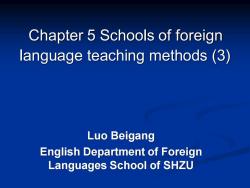
Chapter 5 Schools of foreign language teaching methods (3) Luo Beigang English Department of Foreign Languages School of SHZU
Chapter 5 Schools of foreign language teaching methods (3) Luo Beigang English Department of Foreign Languages School of SHZU
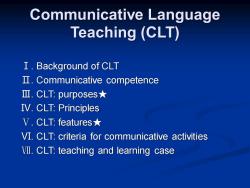
Communicative Language Teaching (CLT) I.Background of CLT II.Communicative competence Ⅲ.CLT:purposes★ IV.CLT:Principles V.CLT:features大 VI.CLT:criteria for communicative activities VII.CLT:teaching and learning case
Communicative Language Teaching (CLT) Ⅰ. Background of CLT Ⅱ. Communicative competence Ⅲ. CLT: purposes★ Ⅳ. CLT: Principles Ⅴ. CLT: features★ Ⅵ. CLT: criteria for communicative activities Ⅶ. CLT: teaching and learning case
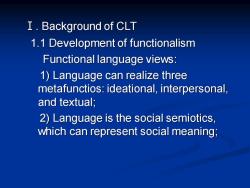
I.Background of CLT 1.1 Development of functionalism Functional language views: 1)Language can realize three metafunctios:ideational,interpersonal, and textual; 2)Language is the social semiotics, which can represent social meaning;
Ⅰ. Background of CLT 1.1 Development of functionalism Functional language views: 1) Language can realize three metafunctios: ideational, interpersonal, and textual; 2) Language is the social semiotics, which can represent social meaning;
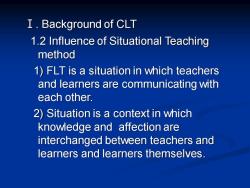
I.Background of CLT 1.2 Influence of Situational Teaching method 1)FLT is a situation in which teachers and learners are communicating with each other. 2)Situation is a context in which knowledge and affection are interchanged between teachers and learners and learners themselves
Ⅰ. Background of CLT 1.2 Influence of Situational Teaching method 1) FLT is a situation in which teachers and learners are communicating with each other. 2) Situation is a context in which knowledge and affection are interchanged between teachers and learners and learners themselves
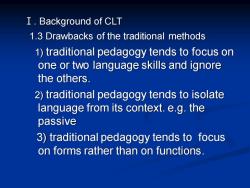
I.Background of CLT 1.3 Drawbacks of the traditional methods 1)traditional pedagogy tends to focus on one or two language skills and ignore the others. 2)traditional pedagogy tends to isolate language from its context.e.g.the passive 3)traditional pedagogy tends to focus on forms rather than on functions
Ⅰ. Background of CLT 1.3 Drawbacks of the traditional methods 1) traditional pedagogy tends to focus on one or two language skills and ignore the others. 2) traditional pedagogy tends to isolate language from its context. e.g. the passive 3) traditional pedagogy tends to focus on forms rather than on functions
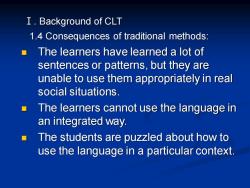
I.Background of CLT 1.4 Consequences of traditional methods: The learners have learned a lot of sentences or patterns,but they are unable to use them appropriately in real social situations. The learners cannot use the language in an integrated way. The students are puzzled about how to use the language in a particular context
Ⅰ. Background of CLT 1.4 Consequences of traditional methods: ◼ The learners have learned a lot of sentences or patterns, but they are unable to use them appropriately in real social situations. ◼ The learners cannot use the language in an integrated way. ◼ The students are puzzled about how to use the language in a particular context
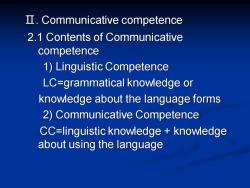
II.Communicative competence 2.1 Contents of Communicative competence 1)Linguistic Competence LC=grammatical knowledge or knowledge about the language forms 2)Communicative Competence CC=linguistic knowledge knowledge about using the language
Ⅱ. Communicative competence 2.1 Contents of Communicative competence 1) Linguistic Competence LC=grammatical knowledge or knowledge about the language forms 2) Communicative Competence CC=linguistic knowledge + knowledge about using the language
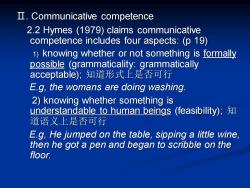
II.Communicative competence 2.2 Hymes (1979)claims communicative competence includes four aspects:(p 19) 1)knowing whether or not something is formally possible (grammaticality:grammatically acceptable);知道形式上是否可行 E.g,the womans are doing washing 2)knowing whether something is understandable to human beings (feasibility); 道语义上是否可行 E.g,He jumped on the table,sipping a little wine, then he got a pen and began to scribble on the floor
Ⅱ. Communicative competence 2.2 Hymes (1979) claims communicative competence includes four aspects: (p 19) 1) knowing whether or not something is formally possible (grammaticality: grammatically acceptable); 知道形式上是否可行 E.g, the womans are doing washing. 2) knowing whether something is understandable to human beings (feasibility); 知 道语义上是否可行 E.g, He jumped on the table, sipping a little wine, then he got a pen and began to scribble on the floor
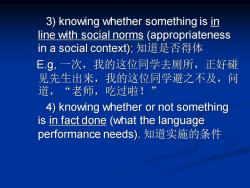
3)knowing whether something is in line with social norms (appropriateness in a social context));知道是否得体 E9,一次,我的这位同学去厕所,正好碰 见先生出来,我的这位同学避之不及,问 道,“老师,吃过啦!” 4)knowing whether or not something is in fact done (what the language performance needs).知道实施的条件
3) knowing whether something is in line with social norms (appropriateness in a social context); 知道是否得体 E.g, 一次,我的这位同学去厕所,正好碰 见先生出来,我的这位同学避之不及,问 道,“老师,吃过啦!” 4) knowing whether or not something is in fact done (what the language performance needs). 知道实施的条件
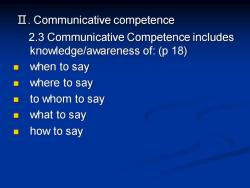
II.Communicative competence 2.3 Communicative Competence includes knowledge/awareness of:(p 18) when to say where to say to whom to say what to say how to say
Ⅱ. Communicative competence 2.3 Communicative Competence includes knowledge/awareness of: (p 18) ◼ when to say ◼ where to say ◼ to whom to say ◼ what to say ◼ how to say
按次数下载不扣除下载券;
注册用户24小时内重复下载只扣除一次;
顺序:VIP每日次数-->可用次数-->下载券;
- 《中学英语教学法》课程教学课件(PPT讲稿)Chapter 5 Schools of FLT methods(4/4).ppt
- 《中学英语教学法》课程教学课件(PPT讲稿)Chapter 5 Schools of FLT methods(2/4).ppt
- 《中学英语教学法》课程教学课件(PPT讲稿)Chapter 8 Teaching strategies(Lead in strategies).ppt
- 《中学英语教学法》课程教学课件(PPT讲稿)Chapter 7 Microteaching skills(Reading).ppt
- 《中学英语教学法》课程教学课件(PPT讲稿)Chapter 9 Class observing strategies.ppt
- 《中学英语教学法》课程教学课件(PPT讲稿)Chapter 6 Contents of FLT(Vocabulary).ppt
- 《中学英语教学法》课程PPT讲稿(学科教学论)Chapter Three Introduction of learning theory(1/2).ppt
- 《中学英语教学法》课程PPT讲稿(学科教学论)Chapter five History of Foreign Language Teaching.ppt
- 《中学英语教学法》课程PPT讲稿(学科教学论)Chapter Four Introduction of SLA Theories(2/2).ppt
- 《中学英语教学法》课程PPT讲稿(学科教学论)Chapter Four Introduction of SLA Theories(1/2).ppt
- 《中学英语教学法》课程PPT讲稿(学科教学论)Chapter Six Introduction of Class Teaching Implementation.ppt
- 《中学英语教学法》课程PPT讲稿(学科教学论)Chapter seven Assessment.ppt
- 《中学英语教学法》课程PPT讲稿(学科教学论)Chapter eight Theories of Test(2/2).ppt
- 《中学英语教学法》课程PPT讲稿(学科教学论)Chapter eight Theories of Test(1/2).ppt
- 《中学英语教学法》课程PPT讲稿(学科教学论)Chapter nine Language Teachers in Classroom Teaching.ppt
- 《中学英语教学法》课程PPT讲稿(课堂教学策略)高中英语课堂观察与评价.ppt
- 《中学英语教学法》课程PPT讲稿(课堂教学策略)英语教师语言敏感意识提升与课堂教学——基于观课的反思.ppt
- 《中学英语教学法》课程PPT讲稿(课堂教学策略)如何开展培训需求分析.ppt
- 《中学英语教学法》课程PPT讲稿(课堂教学策略)树立正确的外语学习观是提高外语教学效率的关键.ppt
- 《中学英语教学法》课程PPT讲稿(课堂教学策略)英语老师行动研究 English Teachers inAction Research.ppt
- 《中学英语教学法》课程教学课件(PPT讲稿)Chapter 5 schools of FLT methods(1/4).ppt
- 《中学英语教学法》课程教学课件(PPT讲稿)Chapter 3 Teaching planning.ppt
- 《中学英语教学法》课程教学课件(PPT讲稿)Chapter 1 Instructional views in New Curriculum.ppt
- 《中学英语教学法》课程教学课件(PPT讲稿)Chapter 4 Teaching designing(Lesson planning).ppt
- 《中学英语教学法》课程教学课件(PPT讲稿)Chapter 2 Key issues in Foreign Language Teaching Methodology.ppt
- 《俄语语法》课程教学大纲 Russian grammar.doc
- 石河子大学:《俄语语法》课程教学资源(试卷习题)2013-2014俄语语法(二)期中答案.doc
- 石河子大学:《俄语语法》课程教学资源(试卷习题)2013-2014俄语语法(二)期中卷.doc
- 石河子大学:《俄语语法》课程教学资源(试卷习题)语法二期末试卷及答案_2013-2014(2)俄语语法(二)A答案.doc
- 石河子大学:《俄语语法》课程教学资源(试卷习题)语法二期末试卷及答案_2013-2014(2)俄语语法(二)A卷.doc
- 石河子大学:《俄语语法》课程教学资源(试卷习题)语法四期末试卷及答案_2013-2014(2)俄语语法(四)A答案.doc
- 石河子大学:《俄语语法》课程教学资源(试卷习题)语法四期末试卷及答案_2013-2014(2)俄语语法(四)B答案.doc
- 石河子大学:《俄语语法》课程教学资源(试卷习题)语法四期末试卷及答案_2013-2014(2)俄语语法(四)A卷.doc
- 石河子大学:《俄语语法》课程教学资源(试卷习题)语法四期末试卷及答案_2013-2014(2)俄语语法(四)B卷.doc
- 《俄语语法》课程教学资源(配课练习,无答案)人名.doc
- 《俄语语法》课程教学资源(配课练习,无答案)时间前置词(1/2).doc
- 《俄语语法》课程教学资源(配课练习,无答案)形容词(1/3).doc
- 《俄语语法》课程教学资源(配课练习,无答案)时间前置词(2/2).doc
- 《俄语语法》课程教学资源(配课练习,无答案)形容词(2/3).doc
- 《俄语语法》课程教学资源(配课练习,无答案)代词.doc
